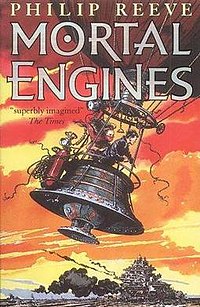Mortal Engines
 |
|
| Author | Philip Reeve |
|---|---|
| Cover artist | David Frankland |
| Country | United Kingdom |
| Language | English |
| Series | Mortal Engines Quartet |
| Genre | Youth Fiction 12 and up. Young Adult/Teen Science fiction |
| Publisher | Scholastic |
|
Publication date
|
2001 |
| Media type | Print (hardback and paperback) |
| Pages | 293 |
| ISBN | |
| OCLC | 50714166 |
| Followed by | Predator's Gold |
Mortal Engines is the first of four novels in Philip Reeve's quartet of the same name. The book focuses on a futuristic, steampunk version of London, now a giant machine striving to survive on a world running out of resources. The book has won a Nestlé Smarties Book Prize and was shortlisted for the 2002 Whitbread Award.
The book is set in a post-apocalyptic world, ravaged by a "Sixty Minute War", which caused massive geological upheaval. To escape the earthquakes, volcanoes, and other instabilities, a Nomad leader called Nikola Quercus installed huge engines and wheels on London, and enabled it to dismantle other cities for resources. The technology rapidly spread, and evolved into what is known as "Municipal Darwinism". Although the planet has since become stable, Municipal Darwinism has spread to most of the world except for Asia and parts of Africa. Much technological and scientific knowledge was lost during the war. Because scientific progress has almost completely halted, "Old Tech" is highly prized and recovered by scavengers and archeologists. Europe, some of Asia, North Africa, Antarctica, and the Arctic are dominated by Traction Cities, whereas North America was so ravaged by the war that it is often identified as "the dead continent", and the rest of the world is the stronghold of the Anti-Traction League, which seeks to keep cities from moving and thus stop the intense consumption of the planet's remaining resources.
London is the principal Traction City in the novel, which has returned to a Victorian-era society. London's society is divided into four major and a number of minor Guilds. The Engineers are responsible for maintaining the machines necessary for the survival of London, many of which are found by the Guild of Historians. The Historians are in charge of collecting and preserving highly prized, often dangerous artifacts. The Navigators are responsible for steering and plotting the course of London. The Merchants are in charge of running London's economy. London is officially ruled by an elected Mayor. The Lord Mayor is Magnus Crome, who is also the head of the Guild of Engineers. Like most Traction Cities, London is built on a series of tiers. This encourages the system of social classes, with the wealthier nobles at the top of the city and the lower classes further down, closer to the noise and pollution of the city's massive engines. Atop the whole of London sits St Paul's Cathedral: the only building known to have survived the Sixty Minute War.
...
Wikipedia
